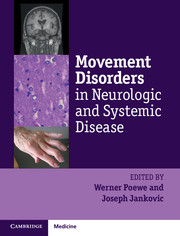Book contents
- Frontmatter
- Contents
- List of contributors
- List of videos
- List of abbreviations
- Preface
- Section I General principles
- Section II Movement disorders in systemic disease
- Section III Iatrogenic and toxic movement disorders
- Section IV Movement disorders in general neurology
- Section V Systemic complications of movement disorders
- Chapter 24 Dysautonomia in movement disorders
- Chapter 25 Gastrointestinal complications of movement disorders
- Chapter 26 Respiratory complications of movement disorders
- Chapter 27 Movement disorders emergencies
- Index
- Plate Section
- References
Chapter 24 - Dysautonomia in movement disorders
from Section V - Systemic complications of movement disorders
Published online by Cambridge University Press: 05 April 2014
- Frontmatter
- Contents
- List of contributors
- List of videos
- List of abbreviations
- Preface
- Section I General principles
- Section II Movement disorders in systemic disease
- Section III Iatrogenic and toxic movement disorders
- Section IV Movement disorders in general neurology
- Section V Systemic complications of movement disorders
- Chapter 24 Dysautonomia in movement disorders
- Chapter 25 Gastrointestinal complications of movement disorders
- Chapter 26 Respiratory complications of movement disorders
- Chapter 27 Movement disorders emergencies
- Index
- Plate Section
- References
Summary
Introduction
The autonomic nervous system (ANS) mediates neuroendocrine, visceral, and behavioral responses to environmental and inner challenges in order to ensure body homeostasis. The insular cortex, together with the medial prefrontal cortex and the extended amygdala, exerts high-order autonomic control on multiple parallel interconnections of the ANS subcortical integrative network constituted from hypothalamus, periaqueductal grey matter, parabrachial pontine complex, and ventro-lateral medullary nuclei (Benarroch 1993). Main output of the central ANS runs through pre-ganglionic sympathetic and parasympathetic cholinergic neurons, the former located in the intermediolateral columns of the thoraco-lumbar spinal cord, the latter in the brainstem and sacral spinal metameria. Parasympathetic cholinergic post-ganglionic fibers arise from ganglia which are generally located close to or within the target organ. Regional activation of parasympathetic fibers induces myosis, promotes salivation, intestinal peristalsis, vesical detrusor contraction, penis (clitoral) engorgement, and decreased heart rate. Noradrenergic sympathetic post-ganglionic neurons originate from the paravertebral ganglia and mediate midriasis, blood vessel constriction, and inotropic and cronotropic cardiac effects, among others. Further, a subgroup of cholinergic sympathetic fibers runs stimulation to cutaneous sweat glands (Goldstein 2006).
Disorders of the ANS are described as primary, if displaying a neurodegenerative origin, or secondary, if developing after brain injury of any cause or metabolic diseases like diabetes. The first report of degenerative dysautonomia dates back to 1925 when Bradbury and Egglestone described a case of orthostatic hypotension (OH) with impotence and anhidrosis of idiopathic origin (Bradbury et al. 1925). In the 1960s Shy and Drager further reported the case of two men who developed multi-domain autonomic failure along with cerebellar, parkinsonian, and pyramidal signs (Shy et al. 1960). Since then, dysautonomia (see Table 24.1) has been recognized as a major non-motor feature of multiple system atrophy (MSA), Parkinson’s disease (PD), as well as other movement disorders with prominent diagnostic, therapeutic, and prognostic implications.
- Type
- Chapter
- Information
- Movement Disorders in Neurologic and Systemic Disease , pp. 363 - 382Publisher: Cambridge University PressPrint publication year: 2014
References
- 1
- Cited by



